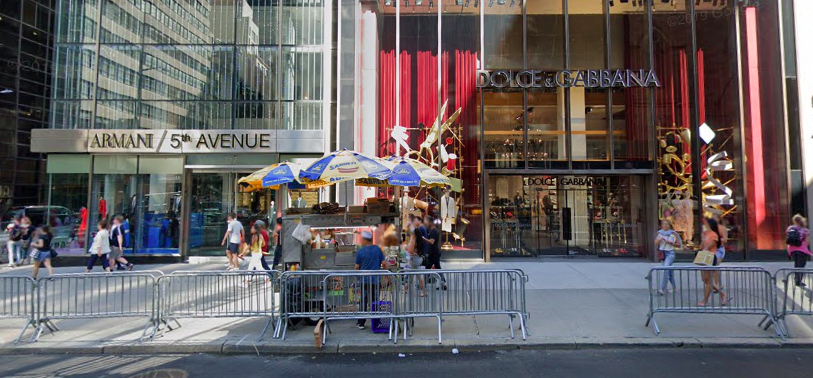Members of a Manhattan civic panel are putting feelings ahead of facts to stall a life-saving street redesign of Fifth Avenue — the same sentiment that ignited the city’s original war on e-bikes — even though just one pedestrian has been injured by a cyclist since the start of 2019.
Manhattan Community Board 5 Vice Chairman Sam Levy announced Thursday night that the panel would not vote on a long-delayed plan to ban thru traffic and add a protected bike lane and pedestrian improvements to part of Manhattan’s most famous avenue in a bid to speed up buses and make the roadway safer — and would not vote until the Department of Transportation responded to the board’s letter calling for more enforcement of cyclists, even though statistics do not suggest bike riders are an issue.
“Despite the fact that we are keenly aware that cars and trucks kill more people than bikes do ... we’re talking about a perception of safety here," Levy said during the full board meeting on Thursday night. "It’s just like anything, if you feel like you can’t walk across the street without being run over by a bike, it doesn't matter necessarily whether the bike will actually run you over. But it’s important to address the fact that people are frightened."
Thursday’s meeting was the latest in a string of hearings and meetings that followed Mayor de Blasio's June 2020 announcement that he intended to turn Fifth Avenue into a car-free busway by that summer — a key COVID recovery initiative to make commutes faster for about 110,000 people a day.
But summer, fall, and winter 2020 came and went without a busway or any firm plans to redesign Fifth Avenue, after DOT capitulated to such Mom and Pop retailers as Hermes and Tiffany that opposed the busway because they wanted shoppers to be able to drive directly to their storefronts along one of the world’s most-expensive streets.
Last month, DOT reps again presented the plan for Fifth Avenue between 59th and 34th streets to a board committee [PDF] — but agency rep Kimberly Rancourt offered no updates about the busway, but said DOT would be moving forward with its installation of a curbside protected bike lane this summer.
The committee was unable to vote because it lacked a quorum, so the bikelash buck was passed to the full board meeting — when again, the board declined to support the safety and transit redesign and voted instead to send a missive to DOT calling for the agency to step up its education and enforcement against cyclists, said Levy.
"In every resolution we have asked for bike or cyclist education and enforcement of existing cycling-related laws. This presentation did not even mention any measures to be taken...measures are not being taken on bike safety, or are potentially even being willfully ignored," he said during Thursday's meeting.
Levy also said the board felt unable to come to a resolution because DOT presented its plans in "a piecemeal approach," lacked a clear timeline, and felt that more "dialogue is required."
That same fear-mongering is what kickstarted the city’s war on e-bikes, when de Blasio gave more weight to one fearful Upper West Sider who bemoaned them on public radio than to his own police department’s statistics. Streetsblog reported that, despite the NYPD’s crackdown on e-bikes — whose riders are mostly low-income immigrant men — they caused just 31 of the reported 45,775 motor vehicle collisions that resulted in injuries in 2018, or roughly .07 percent. And e-bikes injured 32 people in all — or just .05 percent of the 61,939 injuries that year.
And it’s what’s continuing to empower an Upper West Side community board from discriminating against delivery workers on e-bikes, by demanding they be barred from protected bike lanes, as Streetsblog has reported.
Providing a protected bike lane generally makes streets safer for all users — Transportation Alternatives recently showed that protected bike lanes reduce cycling on the sidewalk by 94 percent, and the DOT says crashes drop by 15 percent and pedestrian injuries drop by 21 percent after such lanes are installed. And besides, Fifth Avenue is not currently unsafe because of cyclists.
Car, van and truck drivers have caused 430 reported crashes on Fifth Avenue, between 59th and 34th streets, since January, 2019, injuring 28 cyclists, 21 pedestrians and 57 motorists, according to city statistics. Cyclists and e-bikers have injured one pedestrian in the same period, according to the same statistics, despite a continuous bike boom on a roadway without a bike lane presently (prior to the pandemic, Fifth Avenue had the highest ridership on a Manhattan corridor without a bike lane, according to DOT).
“Fifth Avenue has so many people biking on it, it’s not safe,” said Samir Lavingia, a Transportation Alternatives member. "We need to make it safe. Adding a bike lane would really help. There’s definitely some concerns about how bike safety and pedestrian safety intersect, and it’s been shown time and time again that when you add a protected bike lane, people use it, which means that the people who bike there get of the sidewalk and feel safer in the street
DOT said it has reviewing the board's letter.






